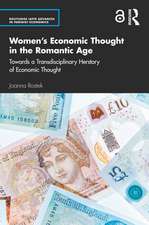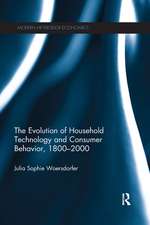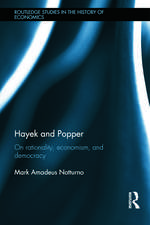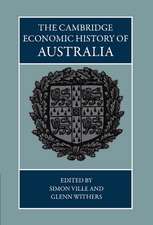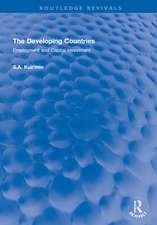An Economic History of Famine Resilience: Routledge Explorations in Economic History
Editat de Jessica Dijkman, Bas van Leeuwenen Limba Engleză Paperback – apr 2021
Societal responses can be coordinated by the state, the market, or civil society. Here it is shown that it was often a combined effort, but that there were significant variations between regions and periods. The long-term, comparative perspective of the volume brings out these variations, explains them, and discusses their effects on societal resilience.
This book will be of interest to advanced students and researchers across economic history, institutional economics, social history and development studies.
| Toate formatele și edițiile | Preț | Express |
|---|---|---|
| Paperback (1) | 384.80 lei 6-8 săpt. | |
| Taylor & Francis – apr 2021 | 384.80 lei 6-8 săpt. | |
| Hardback (1) | 996.04 lei 6-8 săpt. | |
| Taylor & Francis – 26 sep 2019 | 996.04 lei 6-8 săpt. |
Din seria Routledge Explorations in Economic History
- 9%
 Preț: 938.56 lei
Preț: 938.56 lei -
 Preț: 312.65 lei
Preț: 312.65 lei -
 Preț: 310.01 lei
Preț: 310.01 lei -
 Preț: 154.97 lei
Preț: 154.97 lei -
 Preț: 310.96 lei
Preț: 310.96 lei -
 Preț: 310.84 lei
Preț: 310.84 lei -
 Preț: 371.51 lei
Preț: 371.51 lei -
 Preț: 309.12 lei
Preț: 309.12 lei -
 Preț: 380.85 lei
Preț: 380.85 lei - 8%
 Preț: 383.81 lei
Preț: 383.81 lei - 25%
 Preț: 824.17 lei
Preț: 824.17 lei - 18%
 Preț: 1110.22 lei
Preț: 1110.22 lei -
 Preț: 418.89 lei
Preț: 418.89 lei - 21%
 Preț: 304.74 lei
Preț: 304.74 lei - 18%
 Preț: 1059.96 lei
Preț: 1059.96 lei - 18%
 Preț: 1052.03 lei
Preț: 1052.03 lei -
 Preț: 416.41 lei
Preț: 416.41 lei - 25%
 Preț: 1193.01 lei
Preț: 1193.01 lei - 18%
 Preț: 1060.31 lei
Preț: 1060.31 lei - 18%
 Preț: 1174.62 lei
Preț: 1174.62 lei - 25%
 Preț: 766.65 lei
Preț: 766.65 lei - 18%
 Preț: 1422.96 lei
Preț: 1422.96 lei - 18%
 Preț: 1155.05 lei
Preț: 1155.05 lei -
 Preț: 485.14 lei
Preț: 485.14 lei - 18%
 Preț: 1057.20 lei
Preț: 1057.20 lei - 25%
 Preț: 997.11 lei
Preț: 997.11 lei - 18%
 Preț: 1375.15 lei
Preț: 1375.15 lei - 25%
 Preț: 855.59 lei
Preț: 855.59 lei - 18%
 Preț: 1069.62 lei
Preț: 1069.62 lei - 18%
 Preț: 1161.85 lei
Preț: 1161.85 lei - 18%
 Preț: 1118.49 lei
Preț: 1118.49 lei - 25%
 Preț: 851.46 lei
Preț: 851.46 lei - 18%
 Preț: 1166.34 lei
Preț: 1166.34 lei - 42%
 Preț: 195.71 lei
Preț: 195.71 lei - 18%
 Preț: 1052.03 lei
Preț: 1052.03 lei - 18%
 Preț: 1049.25 lei
Preț: 1049.25 lei - 18%
 Preț: 1324.24 lei
Preț: 1324.24 lei - 43%
 Preț: 216.41 lei
Preț: 216.41 lei - 26%
 Preț: 822.54 lei
Preț: 822.54 lei - 18%
 Preț: 1158.20 lei
Preț: 1158.20 lei - 25%
 Preț: 1482.69 lei
Preț: 1482.69 lei -
 Preț: 487.24 lei
Preț: 487.24 lei - 18%
 Preț: 1156.33 lei
Preț: 1156.33 lei - 18%
 Preț: 1050.98 lei
Preț: 1050.98 lei - 18%
 Preț: 1056.86 lei
Preț: 1056.86 lei - 26%
 Preț: 821.53 lei
Preț: 821.53 lei - 25%
 Preț: 851.99 lei
Preț: 851.99 lei
Preț: 384.80 lei
Nou
Puncte Express: 577
Preț estimativ în valută:
73.70€ • 75.93$ • 61.73£
73.70€ • 75.93$ • 61.73£
Carte tipărită la comandă
Livrare economică 22 februarie-08 martie
Preluare comenzi: 021 569.72.76
Specificații
ISBN-13: 9780367776831
ISBN-10: 0367776839
Pagini: 290
Dimensiuni: 156 x 234 x 15 mm
Greutate: 0.41 kg
Ediția:1
Editura: Taylor & Francis
Colecția Routledge
Seria Routledge Explorations in Economic History
Locul publicării:Oxford, United Kingdom
ISBN-10: 0367776839
Pagini: 290
Dimensiuni: 156 x 234 x 15 mm
Greutate: 0.41 kg
Ediția:1
Editura: Taylor & Francis
Colecția Routledge
Seria Routledge Explorations in Economic History
Locul publicării:Oxford, United Kingdom
Public țintă
Postgraduate and UndergraduateNotă biografică
Jessica Dijkman is Assistant Professor in economic history at Utrecht University, the Netherlands.
Bas van Leeuwen is Senior Researcher at the International Institute of Social History, the Netherlands.
Bas van Leeuwen is Senior Researcher at the International Institute of Social History, the Netherlands.
Descriere
This volume discusses societal resilience to food crises, examining the responses and strategies at the societal level that effectively helped individuals and groups to cope with drops in food supply in various parts of the world over the past two millennia.
Cuprins
Contents 1. Resilience to famine ca. 600 BC-present: an introduction Jessica Dijkman and Bas van Leeuwen 1. Central issue 2. Theories and concepts 3. Famine resilience in historical research 4. Some general patterns Part I Premodern world 2. Responses to food shortages in core regions of antiquity compared Bas van Leeuwen and Jieli Li 1. Introduction 2. The nature of famines in core regions 3. Societal resilience 4. Concluding comparison 3. Political, social and economic determinants of responses to food crises in the early Roman empire Luuk de Ligt 1. Introduction 2. Famines and food shortages in the Roman world 3. The food supply of the city of Rome 4. Intervention by provincial governors 5. The role of free trade in resolving urban food crises 6. Public institutions and private benefactors 7. Benefactors, public grain-buyers and the grain market 8. Conclusions 4. Feeding the hungry: Poor relief and famine in northwestern Europe, 1500-1700 Jessica Dijkman 1. Introduction 2. Southeastern England 3. The northwestern Low Countries 4. Northwestern France 5. Conclusions 5. Inca responses to environmental hazards in the capital region and provinces R. Alan Covey 1. Introduction 2. Andean hazards and food supplies 3. Inca state interventions in the Cuzco region 4. Inca state intervention in provincial regions 5. Conclusions 6. Coping with famines in Ottoman Anatolia (1650-1850) Semih Çelik 1. Introduction 2. “There is famine everywhere; no bread to eat” – Bread prices and chronology of famines in Anatolia (1650-1850) 3. Crises in detail 4. Flight, migration and settlement pattern changes 5. Changes in economic activities 6. “If you are subjects of the sultan, so are we!” – Politics of famine resilience 7. “What do you mean by hunger?” – Politics of famine resilience 8. Conclusion Part II Modern world 7. Whose famine? Regional differences in vulnerability and resilience during the 1840s potato famine in Belgium Esther Beeckaert and Eric Vanhaute 1. The 1840s potato famine: la misère des Flandres 2. Methodology and sources 3. Land use and the impact of the crop failures 4. Land holding systems and rural income systems 5. Village politics and local poor relief 6. Whose famine? Explaining the differential vulnerability to a food crisis 8. The integration of food markets and increasing government intervention in colonial Indonesia: 1815 – 1980s Ulbe Bosma 1. Introduction 2. Food self-sufficiency and colonial cash crop production 3. Dysfunctional rice markets and precarity (1850–1900) 4. Government intervention under the Ethical Policy (1900–1930) 5. The Depression years: Towards Indonesian rice self-sufficiency 6. The Republic of Indonesia under Sukarno 7. Suharto’s central coordination: Bulog 8. Conclusion 9. Famine, relief and the rhetoric of welfare in colonial North India Sanjay Sharma 1. Introduction 2. Indigenous Charity: Norms and Practices 3. Colonial Famine Relief and its characterization of ‘Native’ Charity 4. Regulating Alms-Giving and Beggary: Poorhouses and Philanthropy 5. The Colonial State turns Philanthropic: Claims and Legacies 10. Societal responses to food shortages and famine in Russia and China S.G. Wheatcroft 1. Introduction 2. China and Russia in the periods in which they coped well with food problems 3. China and Russia in their times of troubles – ongoing critical food crises and famines 4. Russia and China in the periods of crash reconstruction, attempts to escape from crisis and denial of famine 5. Conclusion 11. Preventable famines: response and coordination failures in 21st century famines Stephen Devereux 1. Introduction 2. Ethiopia 1999–2000 3. Malawi 2001–2002 4. Niger 2005 5. Somalia 2011 6. Discussion 7. Conclusion Part III Long-run perspectives 12. Centralized vs. decentralized: Dealing with famines in China and Poland (a long-term analysis) Meimei Wang, Piotr Koryś and Maciej Tymiński 1. Introduction 2. Societal responses to drops in food supply in China
3. Societal responses to drops in food supply in Poland 4. Conclusions 13.The final straw that broke the camel’s back: famine and migration, a global exploration Leo Lucassen 1. Introduction 2. Defining famine and migration 3. Acute food crises and migration 4. Chronic undernourishment and migration 5.Conclusion
3. Societal responses to drops in food supply in Poland 4. Conclusions 13.The final straw that broke the camel’s back: famine and migration, a global exploration Leo Lucassen 1. Introduction 2. Defining famine and migration 3. Acute food crises and migration 4. Chronic undernourishment and migration 5.Conclusion

